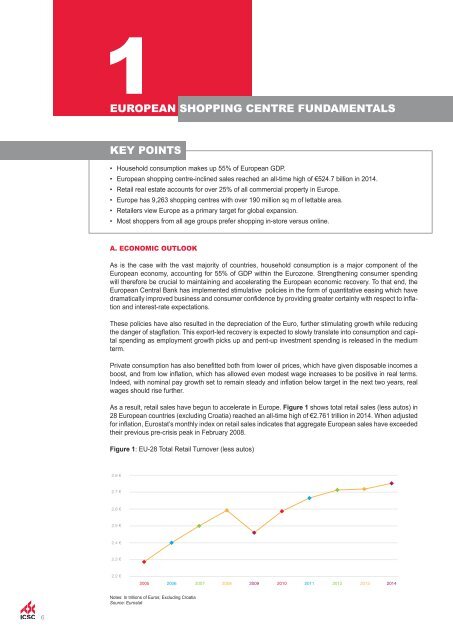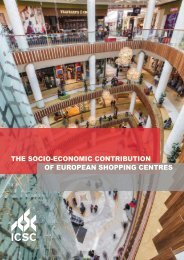THE SOCIO-ECONOMIC CONTRIBUTION OF EUROPEAN SHOPPING CENTRES
Create successful ePaper yourself
Turn your PDF publications into a flip-book with our unique Google optimized e-Paper software.
1<strong>EUROPEAN</strong><br />
<strong>SHOPPING</strong> CENTRE FUNDAMENTALS<br />
KEY POINTS<br />
• Household consumption makes up 55% of European GDP.<br />
• European shopping centre-inclined sales reached an all-time high of €524.7 billion in 2014.<br />
• Retail real estate accounts for over 25% of all commercial property in Europe.<br />
• Europe has 9,263 shopping centres with over 190 million sq m of lettable area.<br />
• Retailers view Europe as a primary target for global expansion.<br />
• Most shoppers from all age groups prefer shopping in-store versus online.<br />
A. <strong>ECONOMIC</strong> OUTLOOK<br />
As is the case with the vast majority of countries, household consumption is a major component of the<br />
European economy, accounting for 55% of GDP within the Eurozone. Strengthening consumer spending<br />
will therefore be crucial to maintaining and accelerating the European economic recovery. To that end, the<br />
European Central Bank has implemented stimulative policies in the form of quantitative easing which have<br />
dramatically improved business and consumer confidence by providing greater certainty with respect to inflation<br />
and interest-rate expectations.<br />
These policies have also resulted in the depreciation of the Euro, further stimulating growth while reducing<br />
the danger of stagflation. This export-led recovery is expected to slowly translate into consumption and capital<br />
spending as employment growth picks up and pent-up investment spending is released in the medium<br />
term.<br />
Private consumption has also benefitted both from lower oil prices, which have given disposable incomes a<br />
boost, and from low inflation, which has allowed even modest wage increases to be positive in real terms.<br />
Indeed, with nominal pay growth set to remain steady and inflation below target in the next two years, real<br />
wages should rise further.<br />
As a result, retail sales have begun to accelerate in Europe. Figure 1 shows total retail sales (less autos) in<br />
28 European countries (excluding Croatia) reached an all-time high of €2.761 trillion in 2014. When adjusted<br />
for inflation, Eurostat’s monthly index on retail sales indicates that aggregate European sales have exceeded<br />
their previous pre-crisis peak in February 2008.<br />
Figure 1: EU-28 Total Retail Turnover (less autos)<br />
2.8 €<br />
2.7 €<br />
2.6 €<br />
2.5 €<br />
2.4 €<br />
2.3 €<br />
2.2 €<br />
2005<br />
2006 2007 2008 2009 2010 2011 2012 2013 2014<br />
Notes: In trillions of Euros; Excluding Croatia<br />
Source: Eurostat<br />
6



